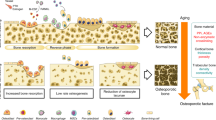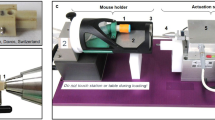Abstract
With demographic change and increasing life expectancy, osteoporotic fractures have become one of the most prevalent trauma conditions seen in daily clinical practice. A variety of factors are known to affect the rate of healing in osteoporotic conditions (e.g. both biochemical and biomechanical environment of callus cells). However, the influence of impairment of mesenchymal stem cell function in the osteoporotic condition on bone fracture healing has not been fully understood. In the present study, we develop a mathematical model that quantifies the change in biological processes within the fracture callus as a result of osteoporosis. The model includes special features of osteoporosis such as reduction in mesenchymal stem cell (MSC) number in osteoporotic bone, impaired response of osteoporotic MSCs to their biomechanical microenvironment and the effects of configuration of locking compression plate (LCP) system on healing in this context. The results presented here suggest that mechanically-mediated MSCs differentiation at early stages of healing are significantly affected under osteoporotic conditions, while it is predicted that the flexible fixation achieved by increasing bone-plate distance of LCP could alleviate the negative effects of osteoporosis on healing. The outcomes of this study could potentially lead to patient specific surgical solutions, and thus achieve optimal healing outcomes in osteoporotic conditions.



Similar content being viewed by others
References
Harvey N, Dennison E, Cooper C (2010) Osteoporosis: impact on health and economics. Nat Rev Rheumatol 6:99–105
Hollevoet N, Verdonk R, Kaufman J-M, Goemaere S (2011) Osteoporotic fracture treatment. Acta Orthop Belg 77(4):441–447
Nikolaou VS, Efstathopoulos N, Kontakis G, Kanakaris NK, Giannoudis PV (2009) The influence of osteoporosis in femoral fracture healing time. Injury 40:663–668
Namkung-Matthai H, Appleyard R, Jansen J, Lin JH, Maastricht S, Swain M, Mason RS, Murrell GAC, Diwan AD, Diamond T (2001) Osteoporosis influences the early period of fracture healing in a rat osteoporotic model. Bone 28(1):80–86
Stolzing A, Scutt A (2006) Age-related impairment of mesenchymal progenitor cell function. Aging Cell 5(3):213–224
Marsell R, Einhorn TA (2011) The biology of fracture healing. Injury 42(6):551–555
Quarto R, Thomas D, Liang CT (1995) Bone progenitor cell deficits and the age-associated decline in bone repair capacity. Calcif Tissue Int 56(2):123–129
Prall WC, Haasters F, Heggebö J, Polzer H, Schwarz C, Gassner C, Grote S, Anz D, Jäger M, Mutschler W, Schieker M (2013) Mesenchymal stem cells from osteoporotic patients feature impaired signal transduction but sustained osteoinduction in response to BMP-2 stimulation. Biochem Biophys Res Commun 440(4):617–622
Haasters F, Docheva D, Gassner C, Popov C, Böcker W, Mutschler W, Schieker M, Prall WC (2014) Mesenchymal stem cells from osteoporotic patients reveal reduced migration and invasion upon stimulation with BMP-2 or BMP-7. Biochem Biophys Res Commun 452(1):118–123
Epari D, Duda G, Thompson M (2010) Mechanobiology of bone healing and regeneration: in vivo models. Proceedings of the Institution of Mechanical Engineers, Part H: Journal of Engineering. Medicine (Baltimore) 224(12):1543–1553
Lacroix D, Prendergast PJ, Li G, Marsh D (2002) Biomechanical model to simulate tissue differentiation and bone regeneration: application to fracture healing. Med Biol Eng Comput 40(1):14–21
Claes LE, Heigele CA, Neidlinger-Wilke C, Kaspar D, Seidl W, Margevicius KJ, Augat P (1998) Effects of mechanical factors on the fracture healing process. Clin Orthop Relat Res 355:S132–S147
Zhang L, Richardson M, Mendis P (2012) The role of chemical and mechanical stimuli in mediating bone fracture healing. Clin Exp Pharmacol Physiol 39:706–710
Klein P, Schell H, Streitparth F, Heller M, Kassi J-P, Kandziora F, Bragulla H, Haas NP, Duda GN (2003) The initial phase of fracture healing is specifically sensitive to mechanical conditions. J Orthop Res 21:662–669
Lacroix D, Prendergast PJ (2002) A mechano-regulation model for tissue differentiation during fracture healing: analysis of gap size and loading. J Biomech 35:1163–1171
Sterck JGH, Klein-Nulend J, Lips P, Burger EH (1998) Response of normal and osteoporotic human bone cells to mechanical stress in vitro. Am J Physiol-Endocrinol Metab 274:E1113–E1120
Bergman RJ, Gazit D, Kahn AJ, Gruber H, Mcdougall S, Hahn TJ (1996) Age-related changes in osteogenic stem cells in mice. J Bone Miner Res 11(5):568–577
Giannoudis P, Schneider E (2006) Principles of fixation of osteoporotic fractures. J Bone Joint Surg Br 88(10):1272–1278
Miramini S, Zhang L, Richardson M, Mendis P (2014) Computational simulation of mechanical microenvironment of early stage of bone healing under locking compression plate with dynamic locking screws. Appl Mech Mater 53:281–286
Miramini S, Zhang L, Richardson M, Mendis P, Ebeling P (2016) Influence of fracture geometry on bone healing under locking plate fixations: a comparison between oblique and transverse tibial fractures. Med Eng Phys 38(10):1100–1108
Miramini S, Zhang L, Richardson M, Mendis P, Oloyede A, Ebeling P (2016) The relationship between interfragmentary movement and cell differentiation in early fracture healing under locking plate fixation. Australas Phys Eng Sci Med 39(1):123–133
Miramini S, Zhang L, Richardson M, Pirpiris M, Mendis P, Oloyede K, Edwards G (2015) Computational simulation of the early stage of bone healing under different locking compression plate configurations. Comput Methods Biomech Biomed Engin 18(8):900–913
Zhang L, Miramini S, Richardson M, Pirpiris M, Mendis P, Oloyede K (2013) The effects of flexible fixation on early stage bone fracture healing. Int J Aerosp Lightweight Struct 3(2):181–189
Zhang L, Miramini S, Richardson M, Ebeling P, Little D, Yang Y, Huang Z (2017) Computational modelling of bone fracture healing under partial weight-bearing exercise. Med Eng Phys 42:65–72
Peiffer V, Gerisch A, Vandepitte D, Oosterwyck HV, Geris L (2011) A hybrid bioregulatory model of angiogenesis during bone fracture healing. Biomech Model Mechanobiol 10(2):383–395
Simpson AHRW, Mills L, Noble B (2006) The role of growth factors and related agents in accelerating fracture healing. J Bone Joint Surg 88(6):701–705
Miramini S, Smith DW, Zhang L, Gardiner BS (2017) The spatio-temporal mechanical environment of healthy and injured human cartilage during sustained activity and its role in cartilage damage. J Mech Behav Biomed Mater 7:1–10
Perren S (1979) Physical and biological aspects of fracture healing with special reference to internal fixation. Clin Orthop Relat Res 138:175–196
Nagel T, Kelly DJ (2010) Mechano-regulation of mesenchymal stem cell differentiation and collagen organisation during skeletal tissue repair. Biomech Model Mechanobiol 9(3):359–372
Andreykiv A, Van Keulen F, Prendergast P (2008) Simulation of fracture healing incorporating mechanoregulation of tissue differentiation and dispersal/proliferation of cells. Biomech Model Mechanobiol 7(6):443–461
Zhang L, Miramini S, Gardiner BS, Smith DW, Grodzinsky AJ (2015) Time evolution of deformation in a human cartilage under cyclic loading. Ann Biomed Eng 43(5):1166–1177
Huiskes R, Van Driel W, Prendergast P, Søballe K (1997) A biomechanical regulatory model for periprosthetic fibrous-tissue differentiation. J Mater Sci Mater Med 8(12):785–788
González-Torres LA, Gómez-Benito MJ, Doblaré M, García-Aznar JM (2010) Influence of the frequency of the external mechanical stimulus on bone healing: a computational study. Med Eng Phys 32:363–371
COMSOL (2012) COMSOL Multiphysics, 4.3 edn. COMSOL Inc, Stockholm
McCartney W, Donald BM, Hashmi M (2005) Comparative performance of a flexible fixation implant to a rigid implant in static and repetitive incremental loading. J Mater Process Technol 169(3):476–484
Anderson CB (1967) Mechanics of fluids. In: Baumeister, T. (Ed.), Marks’ saturated handbook of mechanical engineers. McGraw-Hill Education, New York, p 3.48–43.76
Schaffler MB, Burr DB (1988) Stiffness of compact bone: effects of porosity and density. J Biomech 21(1):13–16
Cowin SC (1999) Bone poroelasticity. J Biomech 32(3):217–238
Stoffel K, Dieter U, Stachowiak G, Gächter A, Kuster MS (2003) Biomechanical testing of the LCP–how can stability in locked internal fixators be controlled? Injury 34:11–19
Claes L, Reusch M, Göckelmann M, Ohnmacht M, Wehner T, Amling M, Beil FT, Ignatius A (2011) Metaphyseal fracture healing follows similar biomechanical rules as diaphyseal healing. J Orthop Res 29(3):425–432
Neidlinger-Wilke C, Stalla I, Claes L, Brand R, Hoellen I, Rübenacker S, Arand M, Kinzl L (1995) Human osteoblasts from younger normal and osteoporotic donors show differences in proliferation and TGF-β release in response to cyclic strain. J Biomech 28(12):1411–1418
García-Aznar JM, Kuiper JH, Gómez-Benito MJ, Doblaré M, Richardson JB (2007) Computational simulation of fracture healing: influence of interfragmentary movement on the callus growth. J Biomech 40(7):1467–1476
Cheal EJ, Mansmann KA, DiGioia III AMD, Hayes WC, Perren SM (1991) Role of interfragmentary strain in fracture healing: ovine model of a healing osteotomy. J Orthop Res 9(1):131–142
Gardner MJ, Nork SE, Huber P, Krieg JC (2010) Less rigid stable fracture fixation in osteoporotic bone using locked plates with near cortical slots. Injury 41(6):652–656
Claes L (2011) Biomechanical principles and mechanobiologic aspects of flexible and locked plating. J Orthop Trauma 25:S4–S7
Ding W-G, Wei Z-X, Liu J-B (2010) Reduced local blood supply to the tibial metaphysis is associated with ovariectomy-induced osteoporosis in mice. Connect Tissue Res 52(1):25–29
Beamer B, Hettrich C, Lan J (2010) Vascular endothelial growth factor: an essential component of angiogenesis and fracture healing. HSSJ 6:85–94
Acknowledgements
The authors would like to thank AOTRAUMA Asia Pacific (AOTAP14-02) and Victorian Orthopaedic Research Trust (2015–2016) for their supports.
Author information
Authors and Affiliations
Corresponding author
Ethics declarations
Conflict of interest
The authors declare that they have no conflict of interest.
Ethical approval
This research did not involve any human participants or animal experiments.
Rights and permissions
About this article
Cite this article
Zhang, L., Miramini, S., Richardson, M. et al. The role of impairment of mesenchymal stem cell function in osteoporotic bone fracture healing. Australas Phys Eng Sci Med 40, 603–610 (2017). https://doi.org/10.1007/s13246-017-0566-y
Received:
Accepted:
Published:
Issue Date:
DOI: https://doi.org/10.1007/s13246-017-0566-y




